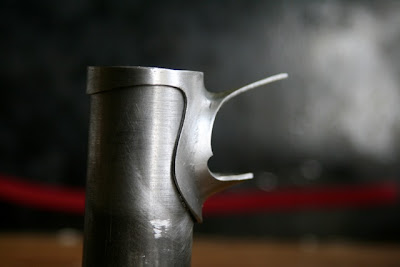I've had a year and a half—the time since I finished Niles—to think about a "signature" lug shape. I've been carving it out (on the same two lugs) slowly over the last year or so. After many hours of filing and pondering, I present my lug shape:
This was carved out of a Prugnat "Type S" lug and now scarcely resembles
the original. I got the idea for the shape around the headtube from the
Prugnat 62bis shape (which my bike
Briggs has) but wanted to make it simpler. After I'd more or less carved the shape into the lug, I saw
this photo on Peter Weigle's incomparably beautiful and instructive
Flickr site. That gave me the idea of carrying the curve further forward. In general mine is a bit less swoopy than his.
I like long points on the top of the lugs, so I left the Prugnats long, but thinned them out quite a bit. I spooned off the lower point for practical reasons (no can-opener effect with these lugs!) and also to make these as much as possible like
Cinelli CS lugs (either Prugnat was copying them or they were copying Prugnat; they're almost identical.)
The second curve on the side of the lug—which the attentive will notice is
new—is a nod to the
Herse/Singer lug shape. But I didn't want to overwhelm the otherwise Italian look of the lug shape, and I didn't want to feel like a copycat or bandwagon jumper, so I made it as subtle as possible.
Here's the lower head lug:
Overall the shape is a hybrid of
Cinelli-style Italian long points,
French double-curve, and general
Peter Weigle voluptuousness. I'm really happy with the way it looks. I think it will "fit" with racing bikes and randonneurs, and with slight modifications to touring and city bikes. And it should be very nice to braze with: very "lightweight," and with lots of well-placed swoops and cutouts close to the miters to be sure that the silver's where it should be.
Speaking of silver: since these are pressed lugs, the tube junctions leave big gaps that silver isn't equal to filling, so I'm going to have to add brass on the inside. This will take a lot of work—but that sort of fits with my general framebuilding ethos! I'll start on that once we've made some fire...
Now that I've got a lug shape I'm happy with (and I do need to straighten out some edges here and there on these particular lugs...) my next obsession is
seatstay attachment styles. My main practical consideration is to do with centerpull braze-ons. All Mafacs except Raids want to be spaced at 62mm (enlarge the image at right, and bookmark this page—that image is a treasure-trove of useful information!) This is really narrow, and places the braze-ons precariously on the inside of the chainstay if you use normal seatstay caps. Peter Weigle's
unbelievably elegant curved seatstay bridge exists not only because it's pretty, but also to reinforce the tenuously-placed Mafac bosses.
So I've been thinking of ways of narrowing the space between the stays where the centrepull bosses are brazed on.
Fastbacks will set things too close together, and I don't think they fit aesthetically with a randonneur. So I'm thinking of doing a hand-miter that replicates the ingenious effect of the
Cinelli plugs that
Mariposa used: they're mitered to the side of the seatlug, so they pull the stays a bit closer together. (I prefer not to use the actual plugs for the aforementioned reason: I like to do things by hand if I can—and it will be lighter this way!)
The other option is to use Weinmann or Dia Compe 610 centrepulls. I don't like the way they look as much, but their bosses sit at 67mm from one another, which is a much more useful spacing, and better for fender clearance too.
(This was a pretty fun post to write, with lots of links to the people, bikes, and sites I like the most—Mariposa, Peter Weigle, Classic Rendezvous, VeloWorks, Bicycle Classics, Bicycle Quarterly, Prugnat, Cinelli, Alex Singer, René Herse, Mafac, Daniel Rebour, etc!)
















































